Theme Parks & Themed Entertainment
Everything’s big about Universal Orlando’s opening-in-2016 Skull Island: Reign of Kong

For nearly 30 years now — ever since King Kong Encounter
was first added to Universal Studios Hollywood's tram tour back in June of 1986
and that 7 ton, 30 foot-tall animatronic figure began blasting tourists with
his banana breath — theme park goers
have been going ape for this massive movie monster.
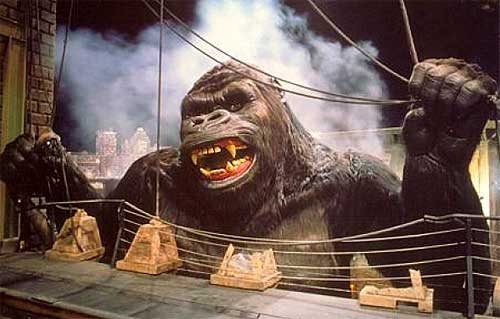
Copyright Universal Studios Hollywood. All rights reserved
Which is why — when the East Coast version of this Hollywood
must-see threw open its gates on June
7, 1990 — one of Universal Studios Florida's opening day
attractions was Kongfrontation. This time around, though, it was a pair of
Kings that menaced the crowds. With each of these 37 foot-tall, 13,000 pound mechanical
creatures attempting to swat an overhead tram full of terrified tourists out of
the sky.
Sadly, Kongfrontation closed its doors back in September
2002 so that its huge show building could then become home to USF's first-ever
indoor roller coaster, Revenge of the Mummy. And as for the oversized
animatronic ape which used to thrill tram riders at Universal Studios Hollywood
… He was lost back when a three alarm fire broke out on the backlot back in
June of 2008. And by the time that conflagration was contacted, King Kong
Encounter had burned to the ground. Along with the original version of Courthouse
Square from "Back to the Future" and
most of USH's New York Street.
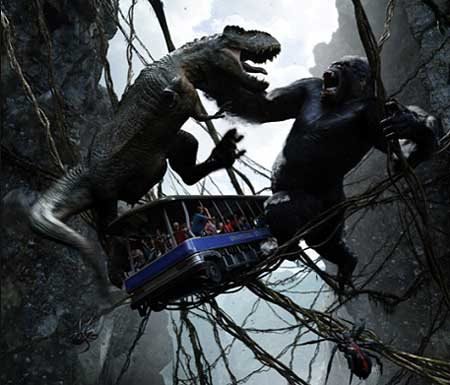
Copyright Universal Studios Hollywood. All rights reserved
But as they say, you can't keep a good man … er … ape
down. Which is why — as soon as that backlot fire at Universal Studios
Hollywood was snuffed out — Universal Creative (i.e., the arm of Universal
Parks & Resorts which designs all of the rides and attractions for
NBCUniversal's theme parks) — began making plans for the return of the King.
Using Peter Jackson's 2005 remake of this cinematic classic as their
jumping-off point, they added King Kong: 360 3-D to the USH tram tour. Which —
thanks to 3-D HD imagery which was then projected onto two 200-foot wide
screens (not to mention a tram motion base plus some wind & water effects)
— gives Universal Studio Hollywood visitors a view to Kong battling a trio of
V-Rexes.
Mind you, as impressive as King Kong: 360 3-D may be, it's
still only a two-and-a-half minute vignette on USH's tram tour. So when
Universal Creative decided that it was time for Kong to make his dramatic
return to the Orlando market, they
didn't just go king-sized with Skull Island:
Reign of Kong. They decided to make this brand-new immersive ride-thru
experience for Universal's Islands of Adventure genuinely massive.

Photo by Jim Hill
"Everything about this ride is going to be big. Take —
for instance — Reign of Kong's ride vehicle. Which is 40 feet-long," Mike
West, the executive producer of this still-under-construction IOA attraction,
stated. "And as for the ride itself … These days, the average theme park
ride is only 4 minutes in length. Whereas Skull
Island: Reign of Kong is going to
be just under six minutes in length. Five minutes and 50 seconds, to be exact.
So we're going to give our guests an exceptionally long ride through a highly
immersive environment. And I know that they won't be disappointed when they
encounter all of the new technology, new tricks & fun things that we're
going to install along Reign of Kong's ride track."
Late last month, the Huffington Post was one of just a
handful of news outlets that got to visit the Skull
Island: Reign of Kong worksite. And
as 300 workmen & artisans climbed scaffolding to finish sculpting &
painting the Great Wall that not only sets the scene for this
opening-in-the-Summer-of-2016 thrill ride but also hides its truly huge show
building, West walked us through this attraction's opening moments.
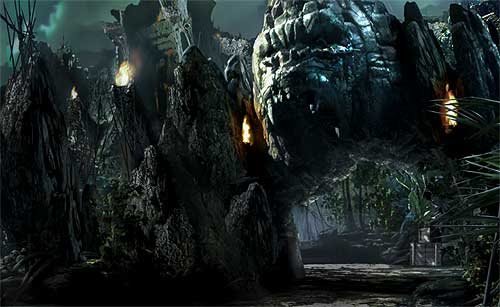
Copyright Universal Orlando. All rights reserved
"Coming off of Islands of Adventure's main promenade,
the guests will first pass the Skull Island:
Reign of Kong marquee and then walk through this attraction's main entrance.
Which is this archway that's capped off with a giant stone version of King
Kong's skull. From here, the guests will find themselves in a dense jungle
surrounded by some rather dead looking plants. And as they make their way
through this jungle, the guests will eventually come across some crates &
supplies & things. Which suggests that an expedition has just landed on Skull
Island," Mike continued.
As Universal Orlando guests make their way through the queue
area which winds back & forth through this expedition's base camp, they'll
then get a lot of Skull Island: Reign of Kong's backstory through a radio
broadcast. An NBC news broadcast from the 1930s, to be exact (Which — given
that Universal Parks & Resorts is the theme park subsidiary of
NBCUniversal, a division of Comcast — only makes sense), complete with authentic-to-the-period
musical interludes from the NBC Orchestra.
"Just beyond the base camp, you'll see the ruins of
this ancient temple. As you make your way along this part of the queue, you'll
eventually enter those ruins. And you go deeper & deeper into this
supposedly abandoned temple; you'll then get a sense of the native presence on Skull
Island. You'll also meet a couple
of characters from the expedition who will then fill you in on even more of
Reign of Kong's backstory before you then continue on to this attraction's load
area," West explained.
And the entire time that guests are making their way through
Skull Island:
Reign of Kong's elaborately themed queue area, they'll be moving from large
open areas to tight spaces. Places that at first confine these theme park
visitors and then suddenly open up. Mind you, this was a deliberate design
choice on Universal Creative's part. All with the idea of this thrill ride's
exterior & interior queue space should properly establish a tone for the
show that's to follow.
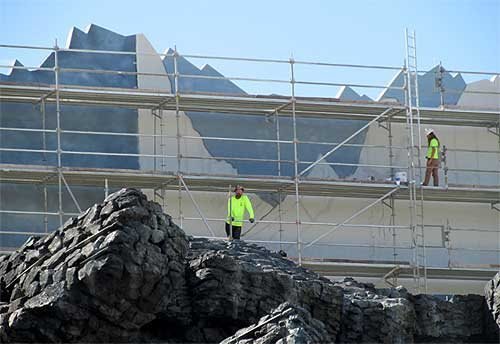
Photo by Jim Hill
"Once they get to Reign of Kong's load area, the guests
hear one more radio broadcast. Which is this transmission from the expedition's
base camp. Which is somewhere deep inside the jungles of Skull
Island. This transmission is
supposed to tell our driver where he or she needs to go once we get out in the
field. More to the point, it hints at what the guests are actually going to
encounter once they finally climb onboard Reign of Kong' s ride vehicle,"
Mike said.
"And once these guests take their seats, this massive
ride vehicle will then come roaring out of the ruins. It'll bounce along this
crumpled temple road before then making a hard right turn. And as our ride
vehicle approaches the Great Wall, you'll hear drums beating. You'll see these
flames flaring up outside the wall. And then — as these massive temple doors
open …," West teased.
It was then that this Universal Creative rep got kind of
cagey. Refusing to go into great detail about what guests will actually
encounter once their ride vehicle actually enters Skull
Island: Reign of Kong's massive
show building.
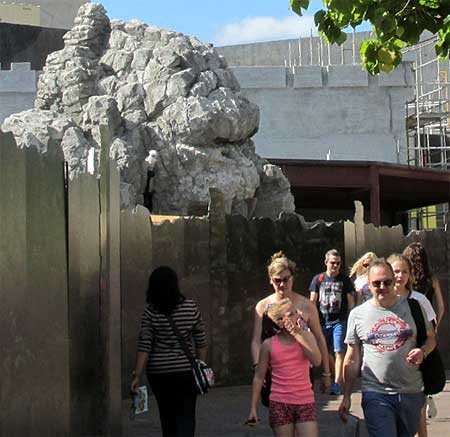
Photo by Jim Hill
"What I can tell you is that — once our guests enter
this attraction — they'll then go through about five or six scenes that are
filled with foreboding dinosaurs and creatures from the underworld that they've
never seen before," Mike stated. "Everything's big and kind of
overwhelming on Reign of Kong. And I think that Universal Orlando visitors are
going to be totally amazed by what they encounter on this ride. It's really
going to be an incredible experience."
But what exactly is this experience going to be like? Is Skull
Island: Reign of Kong a clone of
USH's King Kong: 360 3-D? Will it continue the storyline of Peter Jackson's
2005 "King Kong" remake? Or does Reign of Kong take its inspiration
from that "Skull Island"
movie which Warner Bros. & Legendary Pictures are currently shooting in Hawaii?
West insists that the proper answer to these questions is "None of the
above."

Copyright Universal Orlando. All rights reserved
"This ride is really its own entity. Look, there are
obviously some things — the sculptures in our rockwork, for example — that we
clearly carried over from Peter's 'Kong' movie. But this attraction is different
from that film. It's also different from King Kong: 360 3-D in Hollywood,"
West explained. "Sure, we've taken a few elements from King Kong: 360
3-D. But Skull
Island: Reign of Kong is really its
own land. More to the point, with this ride, we're bringing our guests to Skull
Island for the very first time.
With our previous Kong projects, King Kong has come to the human world. So
we've taken you to places like New York City
where Kong has then gone on a rampage. But this time around, we're taking our
guests into Kong's world. A place where he's in complete control."
"Look, King Kong has obviously been a huge part of
Universal history both in films and in theme park attractions for many years
now. And with Skull Island:
Reign of Kong, we're looking to do some next generation storytelling with this
screen legend. Not have our guests passively experience this attraction but
actually insert them into the story. So that they can then become part of the
Kong legend as they go through this ride," Mike stated.
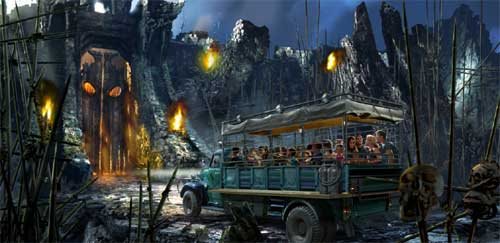
Copyright Universal Orlando. All rights reserved
"And how exactly is Universal Creative going to pull
that off?," you ask. The answer to that question will be revealed in the
Summer of 2016, when the very first ride vehicle rolls out of that elaborate
temple ruin and then rumbles through the gates of Skull
Island: Reign of Kong at
Universal's Islands of Adventure theme park.
This story was originally posted on the Huffington Post's Entertainment page on November 6, 2015
History
The Evolution and History of Mickey’s ToonTown

Disneyland in Anaheim, California, holds a special place in the hearts of Disney fans worldwide, I mean heck, it’s where the magic began after all. Over the years it’s become a place that people visit in search of memorable experiences. One fan favorite area of the park is Mickey’s Toontown, a unique land that lets guests step right into the colorful, “Toony” world of Disney animation. With the recent reimagining of the land and the introduction of Micky and Minnies Runaway Railway, have you ever wondered how this land came to be?
There is a fascinating backstory of how Mickey’s Toontown came into existence. It’s a tale of strategic vision, the influence of Disney executives, and a commitment to meeting the needs of Disney’s valued guests.
The Beginning: Mickey’s Birthdayland
The story of Mickey’s Toontown starts with Mickey’s Birthdayland at Walt Disney World’s Magic Kingdom. Opened in 1988 to celebrate Mickey Mouse’s 60th birthday, this temporary attraction was met with such overwhelming popularity that it inspired Disney executives to think bigger. The idea was to create a permanent, immersive land where guests could step into the animated world of Mickey Mouse and his friends.
In the early ’90s, Disneyland was in need of a refresh. Michael Eisner, the visionary leader of The Walt Disney Company at the time, had an audacious idea: create a brand-new land in Disneyland that would celebrate Disney characters in a whole new way. This was the birth of Mickey’s Toontown.
Initially, Disney’s creative minds toyed with various concepts, including the idea of crafting a 100-Acre Woods or a land inspired by the Muppets. However, the turning point came when they considered the success of “Who Framed Roger Rabbit.” This film’s popularity and the desire to capitalize on contemporary trends set the stage for Toontown’s creation.
From Concept to Reality: The Birth of Toontown
In 1993, Mickey’s Toontown opened its gates at Disneyland, marking the first time in Disney Park history where guests could experience a fully realized, three-dimensional world of animation. This new land was not just a collection of attractions but a living, breathing community where Disney characters “lived,” worked, and played.
Building Challenges: Innovative Solutions
The design of Mickey’s Toontown broke new ground in theme park aesthetics. Imagineers were tasked with bringing the two-dimensional world of cartoons into a three-dimensional space. This led to the creation of over 2000 custom-built props and structures that embodied the ‘squash and stretch’ principle of animation, giving Toontown its distinctiveness.
And then there was also the challenge of hiding the Team Disney Anaheim building, which bore a striking resemblance to a giant hotdog. The Imagineers had to think creatively, using balloon tests and imaginative landscaping to seamlessly integrate Toontown into the larger park.

Key Attractions: Bringing Animation to Life
Mickey’s Toontown featured several groundbreaking attractions. “Roger Rabbit’s Car Toon Spin,” inspired by the movie “Who Framed Roger Rabbit,” became a staple of Toontown, offering an innovative ride experience. Gadget’s Go-Coaster, though initially conceived as a Rescue Rangers-themed ride, became a hit with younger visitors, proving that innovative design could create memorable experiences for all ages.
Another crown jewel of Toontown is Mickey’s House, a walkthrough attraction that allowed guests to explore the home of Mickey Mouse himself. This attraction was more than just a house; it was a carefully crafted piece of Disney lore. The house was designed in the American Craftsman style, reflecting the era when Mickey would have theoretically purchased his first home in Hollywood. The attention to detail was meticulous, with over 2000 hand-crafted, custom-built props, ensuring that every corner of the house was brimming with character and charm. Interestingly, the design of Mickey’s House was inspired by a real home in Wichita Falls, making it a unique blend of real-world inspiration and Disney magic.
Mickey’s House also showcased Disney’s commitment to creating interactive and engaging experiences. Guests could make themselves at home, sitting in Mickey’s chair, listening to the radio, and exploring the many mementos and references to Mickey’s animated adventures throughout the years. This approach to attraction design – where storytelling and interactivity merged seamlessly – was a defining characteristic of ToonTown’s success.

Executive Decisions: Shaping ToonTown’s Unique Attractions
The development of Mickey’s Toontown wasn’t just about creative imagination; it was significantly influenced by strategic decisions from Disney executives. One notable input came from Jeffrey Katzenberg, who suggested incorporating a Rescue Rangers-themed ride. This idea was a reflection of the broader Disney strategy to integrate popular contemporary characters and themes into the park, ensuring that the attractions remained relevant and engaging for visitors.
In addition to Katzenberg’s influence, Frank Wells, the then-President of The Walt Disney Company, played a key role in the strategic launch of Toontown’s attractions. His decision to delay the opening of “Roger Rabbit’s Car Toon Spin” until a year after Toontown’s debut was a calculated move. It was designed to maintain public interest in the park by offering new experiences over time, thereby giving guests more reasons to return to Disneyland.
These executive decisions highlight the careful planning and foresight that went into making Toontown a dynamic and continuously appealing part of Disneyland. By integrating current trends and strategically planning the rollout of attractions, Disney executives ensured that Toontown would not only capture the hearts of visitors upon its opening but would continue to draw them back for new experiences in the years to follow.
Global Influence: Toontown’s Worldwide Appeal
The concept of Mickey’s Toontown resonated so strongly that it was replicated at Tokyo Disneyland and influenced elements in Disneyland Paris and Hong Kong Disneyland. Each park’s version of Toontown maintained the core essence of the original while adapting to its cultural and logistical environment.
Evolution and Reimagining: Toontown Today
As we approach the present day, Mickey’s Toontown has recently undergone a significant reimagining to welcome “Mickey & Minnie’s Runaway Railway” in 2023. This refurbishment aimed to enhance the land’s interactivity and appeal to a new generation of Disney fans, all while retaining the charm that has made ToonTown a beloved destination for nearly three decades.

Dive Deeper into ToonTown’s Story
Want to know more about Mickey’s Toontown and hear some fascinating behind-the-scenes stories, then check out the latest episode of Disney Unpacked on Patreon @JimHillMedia. In this episode, the main Imagineer who worked on the Toontown project shares lots of interesting stories and details that you can’t find anywhere else. It’s full of great information and fun facts, so be sure to give it a listen!
History
Unpacking the History of the Pixar Place Hotel

Pixar Place Hotel, the newly unveiled 15-story tower at the Disneyland Resort, has been making waves in the Disney community. With its unique Pixar-themed design, it promises to be a favorite among visitors.
However, before we delve into this exciting addition to the Disneyland Resort, let’s take a look at the fascinating history of this remarkable hotel.
The Emergence of the Disneyland Hotel
To truly appreciate the story of the Pixar Place Hotel, we must turn back the clock to the early days of Disneyland. While Walt Disney had the visionary ideas and funding to create the iconic theme park, he faced a challenge when it came to providing accommodations for the park’s visitors. This is where his friend Jack Wrather enters the picture.
Jack Wrather, a fellow pioneer in the television industry, stepped in to assist Walt Disney in realizing his dream. Thanks to the success of the “Lassie” TV show produced by Wrather’s company, he had the financial means to build a hotel right across from Disneyland.
The result was the Disneyland Hotel, which opened its doors in October 1955. Interestingly, the early incarnation of this hotel had more of a motel feel than a hotel, with two-story buildings reminiscent of the roadside motels popular during the 1950s. The initial Disneyland Hotel consisted of modest structures that catered to visitors looking for affordable lodging close to the park. While the rooms were basic, it marked the beginning of something extraordinary.
The Evolution: From Emerald of Anaheim to Paradise Pier
As Disneyland’s popularity continued to soar, so did the demand for expansion and improved accommodations. In 1962, the addition of an 11-story tower transformed the Disneyland Hotel, marking a significant transition from a motel to a full-fledged hotel.
The addition of the 11-story tower elevated the Disneyland Hotel into a more prominent presence on the Anaheim skyline. At the time, it was the tallest structure in all of Orange County. The hotel’s prime location across from Disneyland made it an ideal choice for visitors. With the introduction of the monorail linking the park and the hotel, accessibility became even more convenient. Unique features like the Japanese-themed reflecting pools added to the hotel’s charm, reflecting a cultural influence that extended beyond Disney’s borders.
Japanese Tourism and Its Impact
During the 1960s and 1970s, Disneyland was attracting visitors from all corners of the world, including Japan. A significant number of Japanese tourists flocked to Anaheim to experience Walt Disney’s creation. To cater to this growing market, it wasn’t just the Disneyland Hotel that aimed to capture the attention of Japanese tourists. The Japanese Village in Buena Park, inspired by a similar attraction in Nara, Japan, was another significant spot.
These attractions sought to provide a taste of Japanese culture and hospitality, showcasing elements like tea ceremonies and beautiful ponds with rare carp and black swans. However, the Japanese Village closed its doors in 1975, likely due to the highly competitive nature of the Southern California tourist market.
The Emergence of the Emerald of Anaheim
With the surge in Japanese tourism, an opportunity arose—the construction of the Emerald of Anaheim, later known as the Disneyland Pacific Hotel. In May 1984, this 15-story hotel opened its doors.
What made the Emerald unique was its ownership. It was built not by The Walt Disney Company or the Oriental Land Company (which operated Tokyo Disneyland) but by the Tokyu Group. This group of Japanese businessmen already had a pair of hotels in Hawaii and saw potential in Anaheim’s proximity to Disneyland. Thus, they decided to embark on this new venture, specifically designed to cater to Japanese tourists looking to experience Southern California.
Financial Challenges and a Changing Landscape
The late 1980s brought about two significant financial crises in Japan—the crash of the NIKKEI stock market and the collapse of the Japanese real estate market. These crises had far-reaching effects, causing Japanese tourists to postpone or cancel their trips to the United States. As a result, reservations at the Emerald of Anaheim dwindled.
To adapt to these challenging times, the Tokyu Group merged the Emerald brand with its Pacific hotel chain, attempting to weather the storm. However, the financial turmoil took its toll on the Emerald, and changes were imminent.
The Transition to the Disneyland Pacific Hotel
In 1995, The Walt Disney Company took a significant step by purchasing the hotel formerly known as the Emerald of Anaheim for $35 million. This acquisition marked a change in the hotel’s fortunes. With Disney now in control, the hotel underwent a name change, becoming the Disneyland Pacific Hotel.
Transformation to Paradise Pier
The next phase of transformation occurred when Disney decided to rebrand the hotel as Paradise Pier Hotel. This decision aligned with Disney’s broader vision for the Disneyland Resort.
While the structural changes were limited, the hotel underwent a significant cosmetic makeover. Its exterior was painted to complement the color scheme of Paradise Pier, and wave-shaped crenellations adorned the rooftop, creating an illusion of seaside charm. This transformation was Disney’s attempt to seamlessly integrate the hotel into the Paradise Pier theme of Disney’s California Adventure Park.
Looking Beyond Paradise Pier: The Shift to Pixar Place
In 2018, Disneyland Resort rebranded Paradise Pier as Pixar Pier, a thematic area dedicated to celebrating the beloved characters and stories from Pixar Animation Studios. As a part of this transition, it became evident that the hotel formally known as the Disneyland Pacific Hotel could no longer maintain its Paradise Pier theme.
With Pixar Pier in full swing and two successful Pixar-themed hotels (Toy Story Hotels in Shanghai Disneyland and Tokyo Disneyland), Disney decided to embark on a new venture—a hotel that would celebrate the vast world of Pixar. The result is Pixar Place Hotel, a 15-story tower that embraces the characters and stories from multiple Pixar movies and shorts. This fully Pixar-themed hotel is a first of its kind in the United States.
The Future of Pixar Place and Disneyland Resort
As we look ahead to the future, the Disneyland Resort continues to evolve. The recent news of a proposed $1.9 billion expansion as part of the Disneyland Forward project indicates that the area surrounding Pixar Place is expected to see further changes. Disneyland’s rich history and innovative spirit continue to shape its destiny.
In conclusion, the history of the Pixar Place Hotel is a testament to the ever-changing landscape of Disneyland Resort. From its humble beginnings as the Disneyland Hotel to its transformation into the fully Pixar-themed Pixar Place Hotel, this establishment has undergone several iterations. As Disneyland Resort continues to grow and adapt, we can only imagine what exciting developments lie ahead for this iconic destination.
If you want to hear more stories about the History of the Pixar Place hotel, check our special edition of Disney Unpacked over on YouTube.
Stay tuned for more updates and developments as we continue to explore the fascinating world of Disney, one story at a time.
History
From Birthday Wishes to Toontown Dreams: How Toontown Came to Be

In the latest release of Episode 4 of Disney Unpacked, Len and I return, joined as always by Disney Imagineering legend, Jim Shull. This two-part episode covers all things Mickey’s Birthday Land and how it ultimately led to the inspiration behind Disneyland’s fan-favorite land, “Toontown”. But let’s not get ahead of ourselves here. It all starts in the early days at Disneyland.
Early Challenges in Meeting Mickey
Picture this: it’s the late 1970s and early 1980s, and you’re at Disneyland. You want to meet the one and only Mickey Mouse, but there’s no clear way to make it happen. You rely on Character Guides, those daily printed sheets that point you in Mickey’s general direction. But let’s be honest, it was like finding a needle in a haystack. Sometimes, you got lucky; other times, not so much.

Mickey’s Birthdayland: A Birthday Wish that Came True
Fast forward to the late 1980s. Disney World faced a big challenge. The Disney-MGM Studios Theme Park was under construction, with the company’s marketing machine in full swing, hyping up the opening of Walt Disney World’s third theme park, MGM Studios, in the Spring of 1989. This extensive marketing meant that many people were opting to postpone their family’s next trip to Walt Disney World until the following year. Walt Disney World needed something compelling to motivate guests to visit Florida in 1988, the year before Disney MGM Studios opened.
Enter stage left, Mickey’s Birthdayland. For the first time ever, an entire land was dedicated to a single character – and not just any character, but the mouse who started it all. Meeting Mickey was no longer a game of chance; it was practically guaranteed.

The Birth of Birthdayland: Creative Brilliance Meets Practicality
In this episode, we dissect the birth of Mickey’s Birthdayland, an initiative that went beyond celebrating a birthday. It was a calculated move, driven by guest feedback and a need to address issues dating back to 1971. Imagineers faced the monumental task of designing an experience that honored Mickey while efficiently managing the crowds. This required the perfect blend of creative flair and logistical prowess – a hallmark of Disney’s approach to theme park design.
Evolution: From Birthdayland to Toontown
The success of Mickey’s Birthdayland was a real game-changer, setting the stage for the birth of Toontown – an entire land that elevated character-centric areas to monumental new heights. Toontown wasn’t merely a spot to meet characters; it was an immersive experience that brought Disney animation to life. In the episode, we explore its innovative designs, playful architecture, and how every nook and cranny tells a story.

Impact on Disney Parks and Guests
Mickey’s Birthdayland and Toontown didn’t just reshape the physical landscape of Disney parks; they transformed the very essence of the guest experience. These lands introduced groundbreaking ways for visitors to connect with their beloved characters, making their Disney vacations even more unforgettable.
Beyond Attractions: A Cultural Influence
But the influence of these lands goes beyond mere attractions. Our episode delves into how Mickey’s Birthdayland and Toontown left an indelible mark on Disney’s culture, reflecting the company’s relentless dedication to innovation and guest satisfaction. It’s a journey into how a single idea can grow into a cherished cornerstone of the Disney Park experience.

Unwrapping the Full Story of Mickey’s Birthdayland
Our two-part episode of Disney Unpacked is available for your viewing pleasure on our Patreon page. And for those seeking a quicker Disney fix, we’ve got a condensed version waiting for you on our YouTube channel. Thank you for being a part of our Disney Unpacked community. Stay tuned for more episodes as we continue to “Unpack” the fascinating world of Disney, one story at a time.
-

 History11 months ago
History11 months ago31 Long-Gone Rides, Shows & Attractions at Disney-MGM (Hollywood Studios)
-

 News & Press Releases8 months ago
News & Press Releases8 months agoDisney Will Bring D23: The Ultimate Disney Fan Event to Anaheim, California in August 2024
-

 History4 months ago
History4 months agoFrom Birthday Wishes to Toontown Dreams: How Toontown Came to Be
-

 Theme Parks & Themed Entertainment12 months ago
Theme Parks & Themed Entertainment12 months agoFrom Aladdin to Indy – How Did We Get an Indiana Jones Stage Show at Disneyland?
-

 Theme Parks & Themed Entertainment11 months ago
Theme Parks & Themed Entertainment11 months agoWhen WDW Had a Racetrack – The Creation of the Walt Disney World Speedway
-

 Film & Movies11 months ago
Film & Movies11 months ago“Indiana Jones and the Search for Indiana Jones”
-

 History4 months ago
History4 months agoUnpacking the History of the Pixar Place Hotel
-

 History3 months ago
History3 months agoThe Evolution and History of Mickey’s ToonTown









